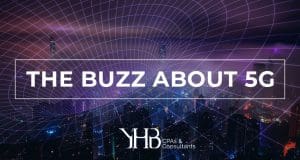 There’s a lot of buzz about 5G right now. We have been through four other incremental changes in our cellular networks and occasionally a new little letter appears beside the cell generation (3G, 4G, 4E, 4G LTE). Should we be paying attention when it bumps to 5? So what if my cell phone will load YouTube and Netflix videos faster. Is that really a problem that needs to be solved for most people?
There’s a lot of buzz about 5G right now. We have been through four other incremental changes in our cellular networks and occasionally a new little letter appears beside the cell generation (3G, 4G, 4E, 4G LTE). Should we be paying attention when it bumps to 5? So what if my cell phone will load YouTube and Netflix videos faster. Is that really a problem that needs to be solved for most people?
Yes and no. The excitement comes when we dream a little about what a faster, more connected network will offer. Previous iterations of cellular network upgrades gave us the ability to call an Uber, use precise GPS and maps while ditching our Garmins, pay with our phones and watches, increase the quality of our photos to 108 megapixels, and countless other efficiency improvements.
5G makes a lot of promises. Here’s a bold prediction from Fortune Magazine: “Like the advent of electrification before it, 5G will transform countries, industries, and societies all over the world, catalyzing unprecedented growth.” Comparing 5G to the proliferation of electricity? Whoa.
The most obvious benefit of 5G is high speed and low latency. Several examples of use cases include:
- Implementation of autonomous vehicles—the software driving (quite literally) self-driving vehicles requires the ingestion, processing and output of large data sets. The current data networks are subject to latency and reduced network speeds because of data volume. The wide pipes of 5G should enable autonomous vehicles to navigate streets more safely.
- Medical technology—the high speed and low latency can enable medical professionals to perform incredible things like remote surgery with laser precision. Or, consider attachment of medical devices to a reliable network. A doctor could establish a monitoring service that aggregates medical KPIs from patients and generates alerts for indicators of declining health. One might consider it like an Intrusion Detection System for your health.
- Manufacturing—one limitation to retooling a manufacturing facility is running cables to the machines. 5G reduces the need to rewire as you retool while you collect and measure the health of the machines. Maybe if 5G were in toilet paper factories, we wouldn’t be in such short supply now.
- Sports stadiums—how often have you attended a college or pro sports game only to find network speeds nearly unusable (I’m looking at you, FedEx field)? 5G could solve that problem and even enhance the experience with augmented reality or real time spectator polls.
Implementation of 5G, however, is not without controversy. The first thing to understand is that not all 5G is created equal. There is an inverse relationship between the speed and distance of coverage. Rough estimates are that the fastest form of 5G, generally referred to as 5G Plus, covers roughly the distance of a city block—about 500 feet. 5G LTE covers more ground, but is comparable to our current 4G LTE speeds. So if you’re thinking 5G is going to solve the rural broadband crisis, it probably won’t.
Another area of concern is the security and deployment of the networks in a corporate environment. Enterprise IT will be slow to adopt a network model that outsources the entire network to a telecom provider. Doing so would reduce the level of control and possibly increase security and availability risks to a company’s systems.
For all the promise, 5G still has some growth to do before we begin to see the benefits. Until then, we can dream up new ways to leverage the tech for when it’s ready for prime time and know that it’s not ‘if’ we get 5G, but when.
LEARN MORE ABOUT OUR RISK ADVISORY SERVICES
 Bryan is a Partner at YHB and serves on the Risk Advisory Services Team. Bryan focuses on assisting organizations in a variety of industries with internal audits and IT-related audit and consulting services.
Bryan is a Partner at YHB and serves on the Risk Advisory Services Team. Bryan focuses on assisting organizations in a variety of industries with internal audits and IT-related audit and consulting services.

